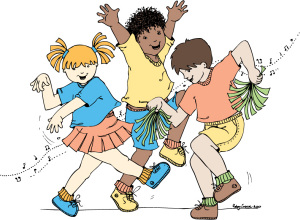Handy Hints

There are lots of handy hints contained in this section to assist you in providing positive, successful movement, music and singing experiences for young children. CONTENTS
LESSON DELIVERY FOR THE EDUCATORWhen adults are delivering movement and music activities to children:
INTEGRATED LEARNINGExcite, Explore, Experience, Express, Educate Activities involving movement and music can be integrated into just about all other areas of learning in the early childhood and early years of education . It can be such an effective, enjoyable way of learning. Integrated learning is all about discovery, exploring, experiences and experimenting. Education trends today are becoming more child centred where the child shows an interest through an observation, free play, creation or discussion. The educator then extends that interest into valuable, well rounded, creative learning opportunities and experiences. Movement and music also allow for the development of the whole child...the physical, social, emotional, cognitive, intellectual and creative development. For example story reading, storytelling, art, craft, manipulative and fine motor activities, outside and inside play, language and numeracy development, construction, imagination and visualization, creativity, problem solving, choice making, social development and experiences, using props, making props, using musical instruments, making musical instruments, fine motor and gross motor activities, songs, chants and poetry can all become part of a child's learning and all triggered, integrated or extended from a single movement or music experience. The learning for the child is then hidden in the fun and participation, in many and varied experiences. The learning becomes whole!
HIDDEN LEARNINGWhen children are having fun they don't realize they are learning! Your challenge as an educator is to be creative in your presentation and delivery of important learning skills. Children need to practise and repeat new and learned skills regularly, so again, be clever in planning your program and hide the learning in the fun and the variety of experiences offered to the children. The children will then stay interested and motivated! Educators should not feel compelled to constantly offer new activities to children but feel comfortable to repeat the same skill over and over but using a different approach. This is where you get creative in your delivery of activities so skills are practised and repeated. This is one of the tricks of great teaching! When skills are continually practiced a fine film called myelin (that covers the axon of the brain cell) starts to get thicker and strengthens. This allows messages from brain cell to brain cell to move faster. The faster the messages travel in the brain the better skilled and co-ordinated the body becomes! Research has shown that the brain is more receptive to picking up and retaining new information when there is no stress and it is an enjoyable experience! Practice and repetition of skills and activities not only enhances brain memory and functioning but also assists in developing muscle memory. The more a child skips or runs (for example), as part of a fun, enjoyable experience, game or activity, the more the muscles remember what they have to do...until the movement or skill becomes automatic. The movement or skill then also becomes more refined, co-ordinated and fluid. (Another simple example of this is when we drink a glass of water. Our arm knows exactly how to stop at the mouth because of all the practice we have putting a cup to the mouth and drinking. The arm does not take the cup to our shoulder or our nose but always to the mouth). You will notice young children use un-coordinated movements when they are learning to drink with a cup. That is because there is immature muscle memory and the brain has not fully developed in this young child yet! Practice = repetition So to summarise...if you want a child to practice balance, vary the activities, don't just provide a balance beam for them to walk along. You can vary the heights of balance or balance in different positions and directions and on different equipment. The children can experience balance through games inside and outside the room. Remember also that balance is enhanced through the stimulation of the vestibular system so lots of spinning and rolling and rotation activities as well! Wow...that's a lot of ways to enhance balance! See more detail about the Vestibular System throughout the Lesson Plans and in the Brain - Body Connection section found in INFORMATION TOPICS. |
